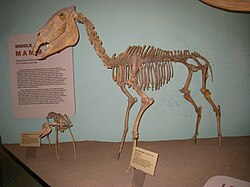Hagerman Horse
| Hagerman horse Temporal range: Middle Pliocene to Late |
|
|---|---|
 |
|
| Mounted skeleton of a Hagerman horse | |
| Scientific classification | |
| Kingdom: | Animalia |
| Phylum: | Chordata |
| Class: | Mammalia |
| Order: | Perissodactyla |
| Family: | Equidae |
| Genus: | Equus |
| Species: | †E. simplicidens |
| Binomial name | |
|
†Equus simplicidens Cope, 1892 |
|
| Synonyms | |
|
|
The Hagerman horse (Equus simplicidens), also called the Hagerman zebra or the American zebra, was a North American species of equid from the Pliocene epoch and the . It was one of the oldest horses of the genus Equus and was discovered in 1928 in Hagerman, Idaho It is the state fossil of Idaho.
The Hagerman horse was given the scientific name of Plesippus shoshonensis in 1930 by a Smithsonian paleontologist named James W. Gidley who led the initial excavations at Hagerman that same year.
However further study by other paleontologists determined that fossils closely resembled fossils of a primitive horse from Texas named Equus simplicidens, named by paleontologist Edward Drinker Cope in 1892. Because of this similarity, the two forms were interpreted to be the same species, and since the name Equus simplicidens was the older name, it was retained following the taxonomic Principle of Priority. The Hagerman fossils represent some of the oldest widely accepted remains of the genus Equus.
A cattle rancher named Elmer Cook discovered some fossil bones on this land in Hagerman, Idaho. In 1928, he showed them to Dr. H. T. Stearns of the U.S. Geological Survey who then passed them on to Dr. James W. Gidley at the Smithsonian Institution. Identified as bones belonging to an extinct horse, the area where the fossils were discovered, called the Hagerman Horse Quarry, was excavated and three tons of specimens were sent back to the Smithsonian in Washington, D.C.
Excavation of the fossils continued into the early 1930s. The Hagerman Horse Quarry floor grew to 5,000 square feet (460 m2) with a backwall 45 feet (14 m) high. Ultimately five nearly complete skeletons, more than 100 skulls, and forty-eight lower jaws as well as numerous isolated bones were found. Some paleontologists believed that such a large amount of fossils found in one location was because of the quarry area being a watering hole at one point. The waterhole could have been where the bones of the Hagerman horses accumulated as injured, old, and ill animals, drawn to water, died there. Other paleontologists think that an entire herd of these animals drowned attempting to ford a flooded river and were swept away in the current and ended up buried in the soft sand at the bottom.
...
Wikipedia
